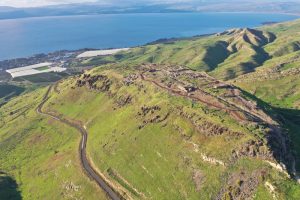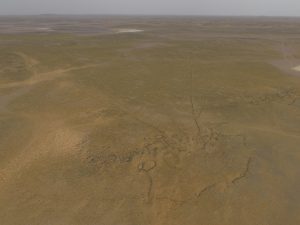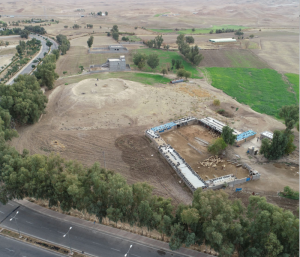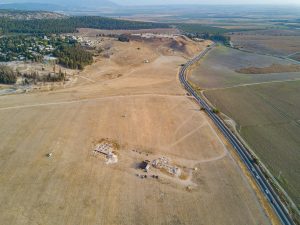
NEW ASOR-AFFILIATED PROJECTS: MAY 2022
ASOR-affiliated projects adhere to ASOR policies, most notably the Non-Discrimination Policy, Policy on Professional Conduct, and Code of Conduct for the ASOR Annual Meeting and Other ASOR Sponsored Events. These policies affirm ASOR’s commitment to high standards for research integrity, academic mentoring and ethical professional behavior. Project Principal Investigators may apply for ASOR affiliation for their projects through the Committee for Archaeological Research and Policy (CAP). Principal Investigators of ASOR-affiliated projects are eligible to apply for ASOR Project Grants and Shepard Urgent Action Grants. Students working on ASOR-affiliated projects are eligible to apply for Scholarships for Fieldwork Participation.
Currently, 98 projects are affiliated with ASOR. This includes 71 field projects and 27 publication projects. Nine field projects (seven new projects and two project renewals) have received ASOR affiliation so far in 2022. Read more about these new ASOR-affiliated projects below!
New ASOR-Affiliated Projects
Birsama Exploration Project, Israel (Alexandra Ratzlaff and Tali Erickson-Gini)
Birsama (Be’er Shema) is situated in the northwest quadrant of the northern Negev, approximately 21 km southeast of Gaza and 25 km northwest of Be’er Sheva. Interest in the site focuses on the presence of a Late Roman fort and associated structures, including the Byzantine church of St. Stephen, a Roman road, pottery kilns and a potential vicus (civilian camp adjacent to the fort). The site appears in the Notitia Dignitatum, distinguished as ‘Birsama’, a provincial military base for the garrison of the Equites Thamudeni Illyriciani. The aim of this project is two-fold 1.) Exploration of the fort and its environs to elucidate new information on this important military and administrative site in relation to the larger late Roman army network in the Negev, 2.) test new digital imaging and modeling methodologies and equipment at the site. The initial 2022 summer season will be an intensive terrestrial and aerial survey of the site to provide key information on the topography and extent of the site. A minimum of five successive excavation field seasons will be carried out beginning in the summer of 2023, followed but a study season for publication preparation. Technological testing of new equipment and methodologies in digital imaging will also form a core component to the recording and exploration of the site. The Brandeis Techne Group, a research team based out of the Autodesk Boston Technology Center, plans to test applications such as multi-drone imaging and use of the Boston Dynamics “Spot the Robot Dog” at the site for terrestrial survey imaging.
Gird-I Matrab Archaeological Project (gMAP), Iraq (Rocco Palermo)
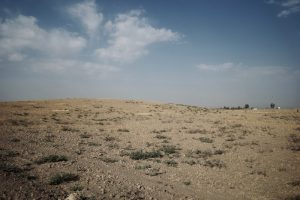
Gird-I Matrab: picture of the main mound
The Gird-I Matrab Archaeological Project (gMAP) investigates the daily life of a small rural settlement in Northern Iraq, its economy, and the impact of climate transformation on the site and its inhabitants from the age of Assyrians to the heirs of Alexander the Great. Gird-I Matrab (“the dusty mound” in Kurdish) is located in the plain of Erbil, in North Iraq. It was already known by Iraqi archaeologists in the 1970s, but only systematically surveyed by the Erbil Plain Archaeological Survey team in 2012 and 2020. The site consists of a group of five low mounds orbiting around a central – slightly higher – one. Geophysical survey carried out in October 2020 have revealed a large and architecturally complex building, whose spatial extent and architectural features indicate a potential administrative function, most likely dated to the last centuries of the 1st millennium BC.
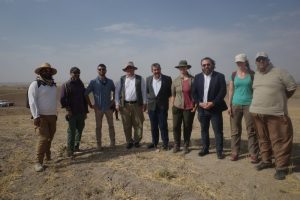
Visit of local representetives with Project Director Dr. Rocco Palermo
While the buried remains have not been physically uncovered yet, the presence of such an articulated building on a relatively small site in North Mesopotamia, might directly provide new dimensions to our understanding of the rural communities of the region in the Hellenistic and following periods.
gMAP plans to investigate the site through and integrated, multi-scalar approach that combines traditional techniques with the use of state-of-the-art technology and scientific analyses.
Hippos Excavations Project, Israel (Michael Eisenberg and Arleta Kowalewska)
Hippos Excavations Project is one of the main continuously running Classical archaeology research expeditions in Israel. Since the year 2000 our international team has excavated the site of Hippos (Sussita) and its environs. Hippos is located upon Mt. Sussita just east of the Sea of Galilee, overlooking the lake and Eastern Galilee.
Hippos’ remains present a continuous sequence from its foundation as Antiochia Hippos in the Hellenistic period (2nd cent. BCE) until the devastating earthquake at 749 CE at the end of the Umayyad rule. As the regional polis and one of the Decapolis it reached its peak during the Roman period. At least seven churches were built in the city during the Byzantine period when it was the see of a bishop.
The Kites in Context Project, Jordan (Chad Hill and Yorke Rowan)
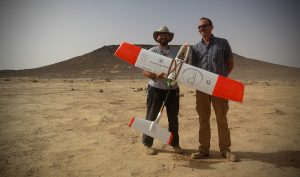
Chad Hill and Yorke Rowan.
This project investigates the social and economic role of ancient animal hunting traps known as “desert kites” during a time of dramatic changing land use, human migrations, and shifting economies. Located in a hyper-arid, basaltic desert, these structures were built as mass-kill traps for ungulates in the later prehistory of the region.
Each chain includes dozens to hundreds of individual traps, spanning tens of kilometers, linked by intricate wall networks that functioned to create one enormous system. These represent a remarkable ancient infrastructural investment in labor, significant social organization, and the ability to generate subsistence surpluses in a marginal environment. This new study of desert kites, in context, focuses on the economy of this desert infrastructure and the social organization of largescale prey-manipulation strategies, to offer new insight into subsistence adaptations in marginal environments. The results from this research have the potential to transform knowledge of human responses and adaptations to arid environments in prehistory.
Menorca Archaeological Project, Torre d’en Galmés, Spain (Alexander Smith, Amalia Pérez-Juez, and Paul Goldberg)
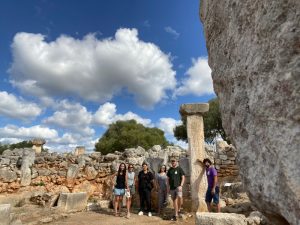
MAP team.
The Menorca Archaeological Project (MAP) is an interdisciplinary group of Spanish and American collaborators that currently focuses on the diachronic investigation of the site of Torre d’en Galmés on the Balearic Island of Menorca. Torre d’en Galmés is one of the largest prehistoric sites on the Balearic Islands, having received international attention from archaeologists for decades. The site’s importance is due both its size and temporal scope. Within the remains of Torre d’en Galmés, one can see on display the early indigenous inhabitants of the island, the impressive remains of the Talayotic culture from the island’s Iron Age, and evidence of Carthaginian and Roman interactions well into the first centuries C.E.
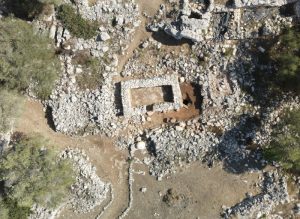
Torre d’en Galmes, aerial view of SpU 9. Photo credit: Alexander Smith.
Long after the site was abandoned during the third or fourth centuries C.E., Torre d’en Galmés was settled once more by Islamic communities that made the island their home during the medieval period. In 1287 C.E., the Islamic settlers were forced to leave the island by King Alfonso III of Aragon, and the rapid depopulation saw the abandonment of sites across the island. Torre d’en Galmés never again saw significant occupation. What remains then is an incredible window into medieval Islamic life in this rural part of Menorca, with dozens of structures preserved, exhibiting the daily life of this group. MAP is dedicated to the archaeological study of the complex history of Torre d’en Galmés, in particular the Islamic medieval remains that have been largely overlooked on the site.
MiSAK, Missione Storico-Archeologica Italiana nel Kurdistan, Sarqala, Iraq (Luca Colliva, Serenella Mancini, Fabrizio Sinisi, Domenico Andreucci, Veronica Castignani, Mehrnaz Partow, and Paolo Severi)
MiSAK, the Italian Historical-Archaeological Mission in Kurdistan, was established in 2021 due to the common interest of ISMEO – the International Association for Mediterranean and Eastern Studies, and the International Institute of Kurdish Culture in Rome to contribute directly and effectively to the study, preservation, and enhancement of the Kurdish historical, archaeological and cultural heritage. MiSAK signed in December 2021 a three-year renewable agreement with the KRG General Directorate of Antiquities for the implementation of an archaeological project concerning the historical-archaeological study, protection and enhancement of the Sarqala site, which includes both the Parthian necropolis and the Qalla Kon tell, a multi-phase site probably part of the settlement connected to the nearby necropolis.
Seeking Sultan Abad-e Chamchamal: Archaeological Excavation at the Site of Tepe Hala Bag, Iran (Mohammad Eghbal Chehri)
According to historical texts, Sultanabad Chamchamal (Solṭānābād) is the most important settlement of the Ilkhanid period in the Bisotun region, which is mentioned in various contemporary historical books with the Ilkhanids due to its great importance. Historical texts show that Sultanabad Chamchamal was built at the foot of Bisotun Mountain and in the western part of Chamchamal plain. The construction of Sultanabad Chamchamal was on the side of the main Khorasan-Baghdad road and in the same area of Bisotun. In fact, despite the efforts of various researchers, the problem of locating and determining the exact location of Sultanabad Chamchamal has not been solved and can be considered as one of the problems in archaeology of the region, and this issue clearly justifies the need for excavation. Based on preliminary studies and archaeological survey, the location of Sultanabad Chamchamal can be considered the same as Halah Bag Tepe. The certainty of this issue, the ability to adapt Tepe Hala Bag with Sultanabad Chamchamal can be understood only by archeological excavation.
ASOR-Affiliated Project Renewals
Jezreel Valley Regional Project, Legio, Israel (Mark Letteney, Matthew J. Adams, Yotam Tepper, and Susan Cohen)
Legio is the site of the sprawling base of the Roman VIth Ferrata Legion. Established during the reign of the Emperor Hadrian (117–138 A.D.), the base controlled imperial roads, with direct access to the Galilee and inland valleys of northern Palestine—important centers of the local, occasionally uproarious, Jewish population. Excavations so far have demonstrated clear ties to major political and cultural events in the formative years of Rabbinic Judaism and Christianity and have provided an incredible new window into the Roman military occupation of the eastern provinces.
Tayinat Archaeological Project, Turkey (Tim Harrison and Elif Denel)
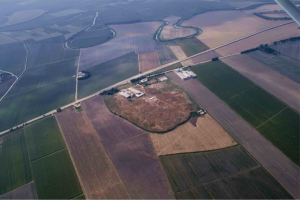
Tell Tayinat from above: Photo by Murat Akar, courtesy of the Tayinat Archaeological Project.
The Tayinat Archaeological Project (TAP) is investigating the archaeological history of the Bronze and Iron Age site of Tell Tayinat, which served as the capital of a succession of small territorial states centered in the Amuq Plain in the North Orontes Valley, Turkey. During the Iron Age, Tayinat was called Kunulua, royal city of the Neo-Hittite Kingdom of Palistin/Patina/Unqi, and Kinalia during the Neo-Assyrian imperial period.
American Society of Overseas Research
The James F. Strange Center
209 Commerce Street
Alexandria, VA 22314
E-mail: info@asor.org
© 2023 ASOR
All rights reserved.
Images licensed under a Creative Commons Attribution-NonCommercial-ShareAlike 4.0 International License
COVID-19 Update: Please consider making payments or gifts on our secure Online Portal. Please e-mail info@asor.org if you have questions or need help.
